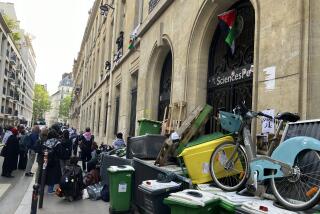Review of San Onofre Reactor Move Expands
Concerned over possible diplomatic repercussions, the U.S. State Department has joined a federal review of Southern California Edison’s request to ship a 668-ton mothballed nuclear reactor around the tip of South America.
Although Edison officials said they did not believe that the expanded review would lead federal regulators to reject the plan, it adds another layer of uncertainty to an already complex -- and controversial -- plan to ship nuclear waste from one coast to the other.
At issue is Edison’s contention that it can move the concrete-encased reactor from the San Onofre Nuclear Generating Station in northern San Diego County to South Carolina’s Barnwell Low Level Radioactive Waste Disposal Facility without entering the territorial waters of any other country.
Edison plans to use two tugboats to move the barge. One tug would make port calls for supplies when needed, leaving the barge far out to sea.
The route would, however, take the barge around Cape Horn, the southern tip of South America and one of the world’s legendarily dangerous stretches of water, and near Chile, which tightly regulates transport of nuclear waste through its waters.
Transportation Department spokesman Joseph Delcambre said regulators sought input from the State Department and the Coast Guard based on details provided last week by Edison, including its contingency plans in case of problems at sea.
“It’s routine in that we do want to cover all the safety angles in transporting a hazardous material like this because it’s such a unique shipment,” Delcambre said. “We want to make sure it’s traveling safely.”
Some of the questions include Edison’s contingency plans and access to ports in the event of trouble, Delcambre said.
“The route is in international waters, but I think as a courtesy the State Department would want to engage with the countries that are along the route to let them know this material was floating by,” he said.
Transportation officials asked the other agencies to submit responses by Tuesday before it begins its final review, Delcambre said.
Edison spokesman Ray Golden said that the utility does not plan to move the barge into any other country’s coastal waters, but it had alerted U.S. Embassy officials in countries along the route.
He acknowledged that an emergency could force the barge into a foreign port, which he said is allowed under international agreements.
“We plan the entire trip to stay in international waters, and we feel that with the redundancy of the tugs the likelihood of having to enter port is remote,” Golden said Friday. “And so we’ve made no provision for it.”
Golden said the reactor has been sealed and, should an accident occur, it could rest on the ocean floor for 500 years without posing an environmental threat. The utility has insured the voyage against accidents, including retrieving the reactor should it sink.
Golden said Edison officials are confident that they will be able to move the reactor this winter. The three-month voyage needs to start by March, he said, to ensure that the barge reaches South Carolina before the onset of next summer’s hurricane season.
The Magellan-like journey is Edison’s latest plan for disposing of San Onofre’s former Unit 1 reactor, which was decommissioned in 1992 and has had high-radiation elements removed.
Edison said the current radioactive levels pose no health threat.
An earlier plan to send the reactor along a shorter route through the Panama Canal fell apart when the canal authority decided the load was too heavy.
More to Read
Start your day right
Sign up for Essential California for news, features and recommendations from the L.A. Times and beyond in your inbox six days a week.
You may occasionally receive promotional content from the Los Angeles Times.







